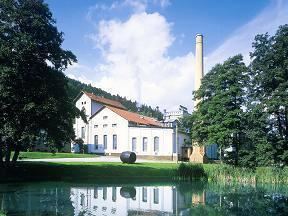- summer (DST) CEST (UTC+2) Area 36.81 km² | Elevation 400 m Local time Thursday 5:58 AM | |
 | ||
Weather -1°C, Wind NW at 11 km/h, 84% Humidity | ||
Hanušovice (German: Hannsdorf) is a town in The Šumperk District of Czech Republic.The Holba brewery is located in the town.
Contents
- Map of HanuC5A1ovice Czechia
- Etymology
- Geography
- History
- Economy
- Demography
- History of population numbers
- Culture sport and architecture
- Architecture
- References
Map of Hanu%C5%A1ovice, Czechia
Etymology
A name is of German descent and consists of two parts. A proper noun of “Hanns” means “John” and a noun “dorf” means “a village”.
Czech name is an approximate loan translation of German original. Correct Czech translation of “John” is “Jan” although it is “Hanuš” in this case. "Hanuš" means “Johhan” in English.
The Czech name also consists of two parts. As already mentioned “Hanuš” means “Johann” and “–ovice” is a suffix creating a noun.
Geography
Hanušovice is situated at a confluence of Morava River and Branná River. The town is in narrow valley surrounded by hills of Hanušovická vrchovina (literally Hanušovice Highlands). A railway junction is not as important as used to be. A passenger transport has been cancelled on a railway to East Bohemia; the track is sporadically used for transporting cargo. A connection to Staré Město is unprofitable and survives with subsidy of Olomoucký kraj administration. Railway connection from Šumperk through Hanušovice to Jeseník keeps its importance.
A town council also administers villages of Hynčice nad Moravou, Potůčník, Vysoké Žibřidovice and Žleb.
Limited administrative services such a registry office and a building authority are provided for municipalities of Staré Město, Kopřivná, Malá Morava, Kopřivná, Šléglov and Vikantice.
History
In 1325, the town was owned by the Kolštejn noble family. Most of Hanušovice was destroyed in the Hussite wars and the Czech-Hungary Wars of the 15th century. The town was repopulated by new settlers afterward. The settlers also established the village of Holba (a contraction of the German word halbseit ("half side"), as the village was on the left side of the road). Later, Hanušovice and Holba were united.
In the 19th century, many factories were opened, but only breweries remain.
Before the Second World War, Hanušovice had 3351 citizens; 556 were Czech, and the rest were German. During the Second World War, the Gross Rosen concentration camp was located nearby, and Polish Jewish women had to work in factories. The English prisoners of war also worked there. After the Second World War, all Germans was expelled to Germany.
Economy
An unemployment rate was 18,5% in 2011.
The town is known for a brewery named Holba. Its production is about 200 000 hectoliters each year. Factory producing ball bearings is situated in south outskirt of the town. Small amphiboliteand gneiss quarry is located near a confluence of Morava River and Krupá Creek.
Other job opportunities are in a retail, forestry and bio agriculture.
Demography
Hanušovice is originally German town. Families of Czech officials and state railways employees immigrated during interwar era because Germans were considered to be too disloyal to work in so strategic sectors such a government administration and a logistic.
Whole German population was expulsed during 1946. Abandoned houses were settled by Czechs from other parts of Czech land, Slovaks, Czech minorities from Soviet Union, especially from Volhynia and Roma mostly from Slovakia.
Slovak minority has been fully assimilated during a time. Nowadays, Hanušovice are Czech town with small Roma community and individuals from Vietnam and Ukraine.
A population was 3352 inhabitants in 2011.
History of population numbers
Culture, sport and architecture
The town hosts popular beer festival every year. The festival known as “Hanušovické pivní slavnosti” is organized by Holba Brewery and is situated in the brewery’s areal. Two stages are presented; first one is used for a performance of popular music and a second one for a performance of brass bands. Special kinds of beers are prepared.
